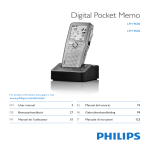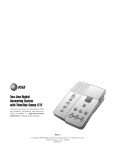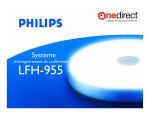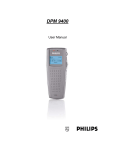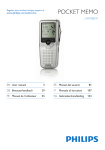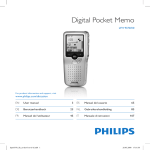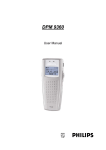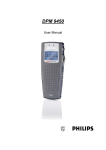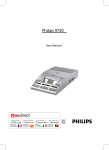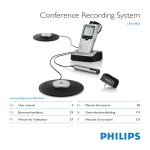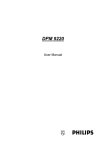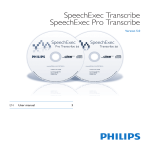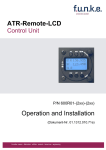Download Philips LFH-9500 User Guide
Transcript
Digital Pocket Memo LFH 9500 LFH 9520 www.philips.com/dictation 3 ES Manual del usuario 63 Benutzerhandbuch 23 NL Gebruikershandleiding 83 Manuel de l‘utilisateur 43 IT Manuale di istruzioni EN User manual DE FR 103 Declaration of Conformity Tested to comply with FCC standards FOR HOME OR OFFICE USE Model Number: LFH 9500 / LFH 9520 Trade Name: Philips Digital Pocket Memo 9500 / 9520 Responsible Party: Philips Speech Processing Address: 64 Perimeter Center East, Atlanta, GA 30346, USA Telephone number:888-260-6261 Website: www.philips.com/dictation This device complies with Part 15 of the FCC Rules. Operation is subject to the following two conditions: 1) This device may not cause harmful interference. 2) This device must accept any interference received, including interference that may cause undesired operation. The CE mark confirms that the device corresponds to the relevant guidelines of the European Union. The cardboard used for packaging can be recycled. This electronic device contains recyclable material. E N G LISH User manual 1 1.1 1.2 1.3 1.4 Welcome 4 Product highlights 4 What’s in the box 4 Overview – controls and connections 5 Overview – display indicators and symbols 6 3.2 3.2.1 3.3 3.3.1 3.3.2 3.3.3 Playback Overview playback functions Delete Delete a file Delete part of a recording Delete all dictations 2 2.1 2.2 2.2.1 4 2.3 2.4 2.5 2.5.1 2.5.2 2.6 Get started 7 Install the batteries 7 Recharge the batteries 7 Recharge the batteries through the USB cable 7 Recharge the batteries through the docking station 7 Recharge the batteries using the optional Philips power supply 8 Insert and eject the memory card 8 Format a new memory card 9 Activate the Digital Pocket Memo 9 Set the language 9 Set the date and time 10 Power-save mode 10 Use more of your Digital Pocket Memo 18 Use Philips SpeechExec software 18 Advanced configuration 18 Download recordings to the PC 18 Use voice-activated recording 19 Work with index marks 20 Insert an index mark 20 Delete an index mark 20 Delete all index marks 20 Assign a keyword 21 Menu settings 21 Menu list 22 3 3.1 3.1.1 3.1.2 3.1.3 3.1.4 3.1.5 3.1.6 Use your Digital Pocket Memo Recording Create a recording Record a spoken instruction Add to a recording (insert/overwrite) Finish (lock) a recording Change the recording format Adjust the microphone sensitivity 2.2.2 2.2.3 User manual 4.1 4.1.1 4.1.2 4.2 4.3 4.3.1 4.3.2 4.3.3 4.4 4.5 4.5.1 15 15 16 16 16 17 11 11 11 12 12 13 14 14 3 1 Welcome Congratulations on your purchase and welcome to Philips! To fully benefit from the support that Philips offers, visit our Website for support information such as user manuals, software downloads and more: www.philips.com/dictation. 1.1 Product highlights • The Digital Pocket Memo’s asymmetrical and ergonomic design delivers unparalleled user-friendly operation. All buttons are within the sweep-angle of the thumb. • Dock the Digital Pocket Memo to the USB Docking Station and transfer your dictation files to the PC in seconds. At the same time, the USB Docking Station can be used to recharge the batteries of the Digital Pocket Memo. • The Digital Pocket Memo is designed around standardized technologies. From SD (SecureDigital) or MMC (Multimedia) cards, mini-USB cables, batteries and sockets to the industry-standard .dss file format for speech processing, Philips employs non-proprietary accessories and technologies for the ultimate compatibility. 1.2 What’s in the box Digital Pocket Memo CD-ROM USB Docking Station Pouch SD memory card Mini-USB cable 2 rechargeable batteries Quick start guide, user manual 4 User manual Overview – controls and connections 1 Digital Pocket Memo 1 Microphone socket 2 Headphone socket 12 3 Built-in microphone 4 Status LED 5 LFH 9500: EOL (end-of-letter) button 11 10 LFH 9520: REC (record) button 6 Slide switch 9 7 On/off switch 8 Speaker 8 9 +/–, menu navigation and volume control 10 Menu button 11 Smart buttons 12 Display 13 Memory card slot 14 LFH 9500: FWD (forward) button LFH 9520: EOL (end-of-letter) button 15 Battery compartment 16 USB connection slot 17 Docking station connection slot 18 Power supply socket USB Docking Station 19 Power supply socket 20 USB connection slot 21 Download indicator LED 23 22 Charge indicator LED 23 Docking slot for the Digital Pocket Memo E N G LISH 1.3 2 3 4 5 6 7 19 20 13 21 22 14 15 18 16 17 User manual 5 1.4 Overview – display indicators and symbols DNote The slide switch has different function placements on each of the two models of the Digital Pocket Memo 9500 series (LFH 9500 and LFH 9520). This user manual will describe functions for both models. Digital Pocket Memo 9500 with international slide switch 6 7 8 9 Digital Pocket Memo 9520 with Philips slide switch 10 6 7 8 9 10 11 5 9:23 12 13 4 14 3 11 5 9:23 12 13 4 3 14 2 DPM 9500 1 KEYWORD NEW 15 2 DPM 9520 1 KEYWORD 19 18 17 16 Current function of the left smart button Keyword 1 (such as author name) 3 Recording number 4 Position bar 5 Recording / playback time 6 Battery level indicator 7 Recording format 8 Memory card is write-protected (locked) 9 Insert recording mode is activated 10 Voice-activated recording in progress 15 19 18 17 16 1 11 Recording 2 12 Sensitivity 6 NEW level meter level for voice-activated recording 13 Current position in the recording 14 Positions of the slide switch 15 Current function of the right smart button 16 Recording is marked finished (EOL) and locked 17 Recording is marked priority 18 Recording contains index mark 19 Recording contains spoken instruction User manual 2.1 Install the batteries The Digital Pocket Memo can be operated with the two rechargeable AAA batteries delivered with the product. Standard (non-rechargeable) AAA alkaline batteries may also be used. 1 The on/off switch of the Digital Pocket Memo must be in the OFF position. 2 Open the battery compartment on the back side of the Digital Pocket Memo by sliding it outwards then folding it up. 3 Insert the two AAA batteries. The correct polarity is indicated on the inside of the battery compartment cover. 1 2 4 Close the battery compartment by folding it down and sliding the battery compartment cover inward until it clicks. 1 2 DNote Do not mix battery types! Use two rechargeable batteries or two non-rechargeable alkaline batteries. User manual 2.2 Recharge the batteries The Digital Pocket Memo can be operated with the rechargeable Philips AAA batteries. To recharge these batteries, use the Docking Station, the USB cable or the optional Philips power supply. 2.2.1 Recharge the batteries through the USB cable When the Digital Pocket Memo is connected to a PC or notebook computer with the supplied USB cable, the rechargeable batteries are automatically recharged. If the USB port on the computer is high powered, a complete recharge cycle takes about 2.5 hours. DNote The PC must be ON when charging battery via the USB cable connection. The Digital Pocket Memo may become warm during fast recharging. CImportant If the USB port of the computer does not supply enough power capacity (500 mA), disable the USB quick charge function in the menu of the Digital Pocket Memo and recharge the batteries using the optional power supply. 2.2.2 Recharge the batteries through the docking station 1 Make sure that the docking station is connected to PC with the USB cable and that the PC is on. 7 E N G LISH 2 Get started 2 Insert the Digital Pocket Memo into the docking slot of the docking station and press it down firmly until it locks. The green LED illuminates, indicating that the batteries of the Digital Pocket Memo are being recharged in fast recharge mode. 3 When the green LED blinks, recharging is complete and the Digital Pocket Memo can be removed from the docking slot. DNote When the Digital Pocket Memo is connected to the docking station, it is powered by the docking station and not by the batteries. If the Digital Pocket Memo is operated with rechargeable batteries, the batteries are automatically recharged while the Digital Pocket Memo is connected to the docking station. 2.3 Insert and eject the memory card The Digital Pocket Memo operates with a SD (SecureDigital) memory card and supports SD cards with storage capacities of up to 2 GB. Your Digital Pocket Memo is packaged with a memory card already inserted and formatted. To eject the memory card: 1 Locate the memory card slot on the top back side of the Digital Pocket Memo. 2 Press the memory card into the Digital Pocket Memo until it clicks. 1 3 Release the memory card. It will slightly emerge from the memory card slot. Simply slide it out. 1 2 2.2.3 Recharge the batteries using the optional Philips power supply 1 Connect the Philips power supply to the main power supply. 2 Connect the Digital Pocket Memo to the Philips power supply. DNote It is okay to continue using the Digital Pocket Memo during recharge. The batteries will be recharged while you work, and will continue recharging even when the Digital Pocket Memo is turned off. 8 To insert a memory card: 1 Locate the memory card slot on the top back side of the Digital Pocket Memo. 2 Slide the memory card into the slot. A small illustration under the memory card slot indicates the correct orientation. 2 3 Push the memory card in until it clicks. User manual the first time, you will be prompted to set the language, date and time. E N G LISH DNote If the Digital Pocket Memo is turned to the ON position and there is no memory card inserted, a warning screen is displayed. 2.4 Format a new memory card When a new, unformatted memory card (or a memory card that was formatted with a nonDigital Pocket Memo device) is inserted, the Digital Pocket Memo will display a prompt to format the memory card. A 1 To confirm and start the formatting process, press the OK smart button 1 . 2 To cancel the formatting process, remove the memory card or press the CANCEL smart button 2 . Format memory A Delete all? Volume Yes -format C All files will be lost ! Font Language BACK B Delete all ? ENTER BACK ENTER 1 2 2.5.1 Set the language When using the Digital Pocket Memo for the first time, you will be prompted to set the language. 1 Press the + or – button 1 on the Digital Pocket Memo to select a language. 2 Press the OK smart button 2 to confirm the selection. The selected language will be displayed. DNote It is possible to change the language later using the menu. See Menu settings on page 21 for more information. DNote Formatting is not possible if the memory card is in read-only mode (locked). 2.5 Activate the Digital Pocket Memo The Digital Pocket Memo is turned on and off by sliding the ON/OFF switch. When using it for User manual 2 1 9 2.5.2 Set the date and time After selecting the user interface language, the Digital Pocket Memo will prompt you to set the current date and time. 1 Press the + or – button 1 to change the value for the year, month or day. 2 Press the → smart button 2 to advance the arrow (↑) to the next entry. 3 After setting the day, press the → smart button 2 to advance the settings to the correct time. 4 Press the + or – button 1 to select a 12-hour or 24-hour clock, AM or PM (if a 12-hour clock is selected), and to change the value of the hour and minute settings. 5 Press the → smart button 2 to confirm the date and time. The Digital Pocket Memo is now ready to function. 2.6 Power-save mode After four minutes of inactivity, the Digital Pocket Memo automatically goes into powersave mode and the LCD screen will display the date and time. Press any button to reactivate it. If the Digital Pocket Memo is not used for more than two hours, it turns off completely. Turn the unit on by moving the On/Off switch to the OFF position and then back to the ON position. 3 2 1 DNote If a mistake is made in setting the date/time, use the ← smart button 3 any time during the procedure to step back to make corrections. It is also possible to change the date and time later using the menu. See Menu settings on page 21 for more information. 10 User manual Memo 3.1 Recording The status LED 5 glows in red (in overwrite mode) or green (in insert mode) while recording. The following information is displayed: a Recording format b Recording time c Current position in the recording d File number e Keyword 1 (author name) 3.1.1 Create a recording Follow these steps to create a recording with the Digital Pocket Memo: 1 A memory card must be inserted into the memory card slot. See Insert and eject the memory card on page 8 for more information. 2 Slide the On/Off switch 1 to the ON position to switch on the Digital Pocket Memo. 3 Press the NEW smart button 2 to create a new recording. D Note The NEW smart button is not displayed if the current recording is empty. 5 To stop recording: • On the Digital Pocket Memo 9500, move the slide switch 4 to the STOP position. • On the Digital Pocket Memo 9520, move the slide switch 4 to the RECP position and press the REC button 3 . 5 a b c d 2 1 4 To start recording: • On the Digital Pocket Memo 9500, move the slide switch 4 to the REC User manual e 3 9:23 #2 4 DPM 9500 INDEX INSTR DNote • For best results, speak clearly and keep the microphone about four inches (ten 11 E N G LISH position and start speaking. • On the Digital Pocket Memo 9520, press the REC button 3 , move the slide switch 4 to the REC position and start speaking. 3 Use your Digital Pocket centimeters) away from your mouth. • A beep will sound when the battery level drops below 10 % or the remaining recording time reaches two minutes. • Press the INDEX smart button during recording or playback to insert an index mark. See Work with index marks on page 20 for more information. • Press and hold the INSTR smart button during recording to record a spoken instruction. See the next chapter for more information. 3.1.2 Record a spoken instruction Spoken instructions are recorded comments by the author that are directed to the person transcribing the dictation. To insert a spoken instruction into a dictation file: 1 Press and hold the INSTR smart button 1 while recording. 2 Dictate the instruction. 3 Release the INSTR smart button 1 when the spoken instruction is complete. The spoken instruction is displayed as a solid line on the file position bar a . 3.1.3 Add to a recording (insert/ overwrite) Files are recorded in overwrite mode by default. Follow these steps to switch to insert mode to make additions to a recording: 1 Press the MENU button 1 while in the stop position to open the menu. 2 Press the + or – button 2 to select the Insert mode menu and press the ENTER smart button 3 to enter the submenu. 3 Press the + or – button 2 to choose between Insert or Overwrite mode. • In insert mode, the record position of the slide switch reads iREC and the status LED 4 glows in green while recording. • In overwrite mode, the record position of the slide switch reads REC and the status LED 4 glows in red while recording. 4 Press the OK smart button 5 to save the setting or press the CANCEL smart button 3 to exit the sub-menu without changing the setting. 5 Press the + or – button 2 to select the file into which the insertion should be made. 4 Delete dictation A B Insert mode Overwrite Keywords Setup a BACK 9:23 #2 12 5 3 1 2 DPM 9500 INDEX ENTER INSTR 1 User manual Digital Pocket Memo 9500 Digital Pocket Memo 9520 5 6 6 9 If the recording is not finished, simply fast forward to the end of the file and continue recording. ⑩ Repeat from step 1 to return to overwrite recording mode. User manual 3.1.4 Finish (lock) a recording When a recording is finished and no additional changes will be made, follow these steps to mark it as finished and protect it from being accidentally deleted: 1 Press the + or – button 1 while in the stop position to select the recording to be marked finished. 2 Press the end-of-letter (EOL) button 2 to lock the file and mark it as finished. The symbol a is displayed. 3 To assign priority status to the recording, press the EOL button 2 again within half a second. The ! symbol b is displayed, indicating that the file has priority status. 4 To make changes to the recording, press the EOL button 2 again to remove the finished mark. Digital Pocket Memo 9500 2 a Digital Pocket Memo 9520 2 a b b 1 1 E Tip Philips SpeechExec software can be configured to download only those files from the Digital Pocket Memo to the PC that are marked finished. C Caution Locked files are deleted when the memory card is formatted or the delete-all-dictations function is used. 13 E N G LISH 6 Play, forward or rewind to the position where the insertion should be made. 7 To insert an additional recording: • On the Digital Pocket Memo 9500, move the slide switch 6 to the iREC position and start speaking. The insertion will not overwrite the recording. • On the Digital Pocket Memo 9520, press the REC button 5 , move the slide switch 6 to the iREC position and start speaking. The insertion will not overwrite the recording. 8 To end the inserted recording: • On the Digital Pocket Memo 9500, move the slide switch 6 to the STOP position. • On the Digital Pocket Memo 9520, move the slide switch 6 to the RECP position and press the REC button 5 . 3.1.5 Change the recording format The recording format determines the audio quality of recordings and affects the number of audio files that can fit on the memory card. The Digital Pocket Memo supports the following recording formats: • Standard Play (SP) requires 1 megabyte for 10 minutes of recording. • Long Play mobile (LPm) requires 1 megabyte for 15 minutes of recording. 1 Press the MENU button 1 while in the stop position to open the menu. 2 Press the + or – button 2 to select the Setup menu item and press the ENTER smart button. 3 3 Press the + or – button 2 to select the Record format menu item and press the ENTER smart button 3 . 4 Press the + or – button 2 to choose between SP and LPm. 5 Press the OK smart button 4 to save the setting or press the CANCEL smart button 3 to exit the sub-menu without changing the setting. Delete dictationA Language Insert mode Record format Keywords Voice activation Backlight Language 14 1 Press the MENU button 1 while in the stop position to open the menu. 2 Press the + or – button 2 to select the Setup menu item and press the ENTER smart button 3 . 3 Press the + or – button 2 to select the Microphone menu item and press the ENTER smart button 3 . 4 Press the + or – button 2 to choose the microphone sensitivity: Private (low), Dictate (medium) and Conference (high). 5 Press the OK smart button 4 to save the setting or press the CANCEL smart button 3 to exit the sub-menu without changing the setting. Delete dictationA Record lamp Insert mode Contrast Keywords Device beep Setup Microphone Language BACK B Dictate ENTER BACK ENTER C 4 3 1 2 C SP <DSS> Setup BACK B 3.1.6 Adjust the microphone sensitivity Set the microphone sensitivity for the environment and your recording preferences. ENTER BACK ENTER 4 3 1 2 User manual Playback 3.2.1 Overview of playback functions 1 Press the + or – button 1 while in the stop position to select the file to play and locate the beginning of the recording. 2 Move the slide switch 2 to the PLAY position to start playback. The following information is displayed: a Recording format b Playback position (minutes : seconds) c Current position in the recording d File number e Keyword 1 (author name) 3 Press the + or – button 1 to adjust the playback volume during playback. 4 Press the SPEED smart button 3 to adjust faster or slower file playback. 5 Move the slide switch 2 to the STOP position to stop playback. a b c d e 5:12 #2 2 DPM 9500 INDEX SPEED File Press the + button 1 once while in the selection stop position to skip to the end of a file. Press the + button again to skip to the beginning of the next file. Press the – button 1 once while in the stop position to skip to the beginning of a file. Press the – button again to skip to the end of the previous file. Fast Move the slide switch 2 to the ┤ position. Move the slide switch to the STOP position rewind to stop rewinding or the PLAY position to stop rewinding and begin playback. Fast On the Digital Pocket Memo 9500, forward press and hold the FWD button 3 while in the stop or play position. Release the FWD button to stop forwarding. On the Digital Pocket Memo 9520, move the slide switch 2 to the ┢ position. Move the slide switch to the STOP position to stop forwarding or the PLAY position to stop forwarding and begin playback. Playback Press the SPEED smart button 4 during playback to adjust faster or slower file speed playback. 3 1 3 2 4 1 User manual 15 E N G LISH 3.2 3.3 Delete D Note Before deleting a file, make sure that it is not marked finished and that the memory card is not set to read-only (locked). If the file is marked finished, unlock it by pressing the EOL button once. 3.3.1 Delete a file Follow these steps to delete a file entirely: 1 Press the + or – button 1 while in the stop position to select the file to be deleted. 2 Press the MENU button 2 to open the menu. The Delete dictation menu item is selected. 3 Press the ENTER smart button 3 to enter the sub menu. 4 Press the OK smart button 4 to delete the file permanently. Press the CANCEL smart button 3 to cancel the operation and leave the recording intact. Delete dictation A Delete ? B Insert mode Keywords Setup BACK ENTER 4 3 2 1 3.3.2 Delete part of a recording Follow these steps to delete a section from a recording: 1 Press the MENU button 1 while in the stop position to open the menu. 2 Press the + or – button 2 to select the Delete section menu item and press the OK smart button 3 . 3 Using the play, forward or rewind functions, navigate to the beginning of the section to be deleted. Press the MARK 1 smart button 4 . A cross symbol appears on the screen. Delete section A B Delete dictation Priority high Index set OK 3 CANCEL 4 1 2 4 Navigate to the second mark position using playback, forward or rewind. Press the MARK 2 smart button 5 . The second cross appears. 5 Press the DELETE smart button 5 and the OK smart button 6 to confirm the deletion of the marked section, or press the CANCEL smart button 5 to exit without deleting. C D 5:34 #2 DPM 9500 CANCEL MARK 2 6 5 16 User manual E N G LISH 3.3.3 Delete all dictations C Caution Files marked finished (EOL) are deleted when the delete-all-dictations function is used. Follow these steps to delete all recordings: 1 Press the MENU button 1 while in the stop position to open the menu. 2 Press the + or – button 2 to select the Setup menu item and press the ENTER smart button 3 . 3 Press the + or – button 2 to select the Delete dictations menu item and press the ENTER smart button 3 . Delete dictation A B Insert mode Keywords Setup Language BACK ENTER 3 1 2 4 Press the ENTER smart button 4 and the OK smart button 5 to confirm the deletion, or press the CANCEL smart button 4 to exit without deleting. C Delete all ? Yes - delete D All dictations will be lost ! BACK ENTER 5 4 User manual 17 4 Use more of your Digital Pocket Memo 4.1 Use Philips SpeechExec software Philips SpeechExec software can be used for advanced configuration of the Digital Pocket Memo, automatic download, conversion and routing of dictation files. 1 Connect the Digital Pocket Memo to the PC using a USB cable. 2 Start Philips SpeechExec Pro Dictate software. 3 Click Settings > General settings on the menu bar of SpeechExec to open the settings menu and select DPM/DT Configuration > DPM Wizard from the list on the left side. 4 Click the Start Wizard… button to open the wizard. Follow the on-screen instructions to customize the Digital Pocket Memo. 5 Click the Finish button to close the wizard and confirm the transfer of the new settings to the Digital Pocket Memo. D Note When the Digital Pocket Memo is connected to the PC for the first time, Windows detects the new hardware and automatically installs the required drivers. When the installation is complete, Windows may prompt you to restart the PC. D Note For detailed information about SpeechExec software, refer to the SpeechExec user manual. 4.1.1 Advanced configuration The Digital Pocket Memo Configuration Wizard is part of the Philips SpeechExec Pro Dictate software. It guides users through the device configurations and settings of the Digital Pocket Memo. The wizard assists in configuring time format, sound feedback, voice-activated recording, display appearance (standard or advanced display mode), recording format, microphone sensitivity, keywords, and file download to the PC. 18 4.1.2 Download recordings to the PC With USB mass storage support, the Digital Pocket Memo is automatically displayed as an external drive when it is connected to the computer. It can then be accessed easily with any Microsoft Windows program as a regular drive. Use Philips SpeechExec software for automatic download, conversion, and routing of files. 1 Make a recording with the Digital Pocket Memo. 2 Start Philips SpeechExec Pro Dictate software. User manual setting or press the CANCEL smart button 3 to exit the sub-menu without changing the setting. Delete dictationA Language Insert mode Record format Keywords Voice activation Backlight Language D Note How and which files are downloaded after a Digital Pocket Memo is connected can be configured in the settings menu of SpeechExec or with the Configuration Wizard. 4.2 Use voice-activated recording Voice-activated recording is a convenience feature for hands-free recording. When voiceactivated recording is enabled, recording will start when you begin speaking. When you stop speaking, the Digital Pocket Memo will automatically pause recording after three seconds of silence, and resume only when you begin speaking again. 1 Press the MENU button 1 while in the stop position to open the menu. 2 Press the + or – button 2 to select the Setup menu item and press the ENTER smart button 3 . 3 Press the + or – button 2 to select the Voice activation menu item and press the ENTER smart button 3 . 4 Press the + or – button 2 to choose Off or On. 5 Press the OK smart button 4 to save the User manual C Off Setup BACK B ENTER BACK ENTER 4 3 1 2 6 To start recording: • On the Digital Pocket Memo 9500, move the slide switch 6 to the REC position and start speaking. • On the Digital Pocket Memo 9520, press the REC button 5 , move the slide switch 6 to the REC position and start speaking. The status LED 7 glows in red (in overwrite mode) or green (in insert mode) while recording. When the sound level drops below the threshold sound level a , recording pauses after three seconds and the status LED flashes. 7 Press the + or – button 8 to adjust the threshold sound level a while recording. 8 To stop recording: • On the Digital Pocket Memo 9500, move the slide switch 6 to the STOP position. • On the Digital Pocket Memo 9520, move the slide switch 6 to the RECP position and press the REC button 5 . 19 E N G LISH 3 Connect the Digital Pocket Memo to the PC using the USB cable or the USB docking station. 4 By default, the recordings on the Digital Pocket Memo will be downloaded automatically to the PC and moved to the Finished dictations folder of the work list. a 7 5 9:23 #2 6 DPM 9500 INDEX INSTR mark to be deleted a . 2 Press the MENU button 1 while in the stop position to open the menu. 3 Press the + or – button 2 to select the Index clear menu and press the OK smart button 3 . 8 B A 4.3 Work with index marks Index marks can be used to mark certain points in a recording as points of reference. A point of reference may be the beginning of a major section, or a part of the recording that you may want to revise later or access quickly. 6:32 #2 a DPM 9500 KEYWORD NEW 3 1 2 4.3.3 Delete all index marks 4.3.1 Insert an index mark 1 Press the INDEX smart button 1 during recording or playback to insert an index mark a . The index number is displayed for two seconds. 9:23 a INDEX 1 A Insert mode DPM 9500 INDEX 1 Press the MENU button 1 while in the stop position to open the menu. 2 Press the + or – button 2 to select the Delete indices menu item and press the ENTER smart button 3 . 3 Press the ENTER smart button 3 and the OK smart button 4 to confirm the deletion, or press the CANCEL smart button 3 to exit without deleting. INSTR 1 Keywords Setup Delete indices B Delete all ? Yes - delete Delete all ? BACK 4.3.2 Delete an index mark ENTER C All indices will be lost ! BACK ENTER 4 3 1 2 1 Play, fast forward or fast rewind to the index 20 User manual 0:00 #2 A Work Type B C Author 1 3 DPM 9500 KEYWORD 4.4 Assign a keyword One or more keywords, such as the author’s name, can be assigned to every recording. Keywords can be used to identify recordings and automatic file routing in Philips SpeechExec software. D Note Keywords must first be set up with Philips SpeechE xec software. See Advanced configuration on page 18 for more information. By default, the keyword category Author with the keywords ‘DPM 9500’ and ‘- - -’ (empty) and the category Work type with the keywords ‘Memo’, ‘Letter’, ‘Fax’ and ‘Report’ are available on the Digital Pocket Memo. To assign a keyword to a recording: 1 Press the KEYWORD smart button 1 while in the stop position to display the list of keyword categories. 2 Press the + or − button 2 to select a category. 3 Press the ENTER smart button to display the list of keywords for the category. 4 Press the + or − button 2 to select a keyword. 5 Press the OK smart button 4 to confirm or the CANCEL smart button 3 to exit without assigning a keyword. User manual NEW BACK ENTER 2 4.5 Menu settings To access the Digital Pocket Memo menu: 1 Press the MENU button 1 while in the stop position to open the menu. 2 Press the + or – button 2 to select the next/previous menu item. 3 Press the ENTER smart button 3 or the MENU button 1 to enter a sub-menu. Press the BACK smart button 4 to exit the menu. 4 Press the + or – button 2 to select a function. 5 Press the OK smart button 4 to confirm a selection or the CANCEL smart button 3 to exit a sub-menu without changing a setting. Delete dictation Insert mode Keywords 4 Setup Language BACK ENTER 3 1 2 21 E N G LISH D Note The Delete Indices menu item is available only if the current file has at least one index mark. 4.5.1 Menu list Dictate. See Advanced configuration on page 18 for more information. Press the MENU button DELETE DICTATION (see 3.3.1 page 16) PRIORITY HIGH / NORMAL (see 3.1.4 page 13) INDEX SET / CLEAR (see 4.3 page 20) INSERT MODE (see 3.1.3 page 12) KEYWORDS (see 4.4 page 21) DELETE ALL INDICES (see 4.3.3 page 20) DELETE SECTION (see 3.3.2 page 16) SETUP LANGUAGE (see 2.5.1 page 9) RECORD FORMAT (see 3.1.5 page 14) VOICE ACTIVATION (see 4.2 page 19) BACKLIGHT (OFF / 8 s / 20 s) RECORD LAMP ON / OFF LCD CONTRAST DEVICE BEEP ON / OFF MICROPHONE SENSITIVITY (see 3.1.6 page 14) DATE & TIME (see 2.5.2 page 10) USB QUICK CHARGE ON / OFF DELETE ALL DICTATIONS (see 3.3.3 page 17) FORMAT MEMORY (see 2.4 page 9) PLAYBACK VOLUME DEVICE FONT (MODERN / CLASSIC) MAIN MENU D Note Press and hold the MENU button for a few seconds to access additional information about files, the device, and the memory card. Disclaimer and Notices Philips performs extensive testing with the most popular configurations. However, since PC addons and device drivers are updated continually, conflict-free operation cannot be guaranteed. SETUP MENU D Note Some settings, such as defining keywords or switching to the simple display mode, are available only through Philips SpeechExec Pro 22 User manual






















